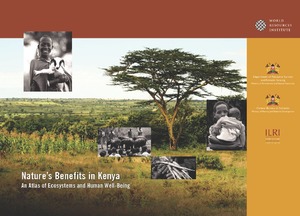Resource information
Nature’s Benefits in Kenya: An Atlas of Ecosystems and Human Well-Being integrates spatial data on poverty and the environment
in Kenya, providing a new approach to examining the links between ecosystem services (the benefits derived from nature)
and the poor. This publication focuses on the environmental resources
most Kenyans rely on to earn their livelihoods, such as soil, water, forest,
rangeland, livestock, and wildlife. The atlas overlays georeferenced
statistical information on population and household expenditures with
spatial data on ecosystems and their services (water availability, wood
supply, wildlife populations, and the like) to yield a picture of how
land, people, and prosperity are related in Kenya.
In Kenya’s national development plans, improving the health and
prosperity of Kenyan families while also safeguarding the natural
environment and the many important economic and spiritual benefits
it provides are identified as top priorities. Attaining these multiple development
goals means that policymakers and civil society groups need
to access information and analysis on the numerous interconnections
among environmental resources, human well-being, and economic
expansion. The maps and analyses presented in this atlas are a first
attempt to provide such information.
This information can be used in developing poverty reduction
programs and in designing policies for water resources management,
agriculture production, biodiversity preservation, and charcoal
production, among others. The maps and analyses presented here
will not provide easy answers to questions concerning the causes of
poverty in Kenya and how ecosystems can best be managed to increase
economic growth and improve livelihoods. But they are a first step
toward stimulating more informed dialogue and provoking questions
for which answers may be found. With up-to-date data and additional
analyses, the implementation of Kenya’s Economic Recovery Strategy
(and its successor strategy) can be targeted to specific geographic areas
of the country, focusing on the poor, and making better use of Kenya’s
natural resources.



